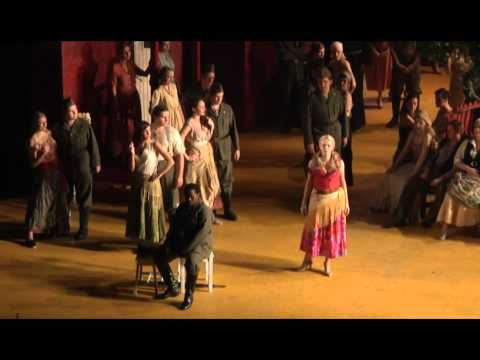5.5: Mezzo-Soprano
- Page ID
- 72377
The vocal range of the mezzo-sopranos lies between the soprano and the contralto voice types. Mezzo-sopranos generally have a heavier, darker tone than sopranos. The mezzo-soprano voice resonates in a higher range than that of a contralto. The terms Dugazon and Galli-Marié are sometimes used to refer to light mezzo-sopranos, after the names of famous singers. A castrato with a vocal range equivalent to a mezzo-soprano’s range is referred to as a mezzo-soprano castrato or mezzista. Today, however, only women should be referred to as mezzo-sopranos; men singing within the female range are called countertenors.
While mezzo-sopranos typically sing secondary roles in operas, notable exceptions include the title role in Bizet’s Carmen, Angelina (Cinderella) in Rossini’s La Cenerentola, and Rosina in Rossini’s Barber of Seville (all of which are also sung by sopranos). Many nineteenth-century French-language operas give the leading female role to mezzos, including Béatrice et Bénédict, La damnation de Faust, Don Quichotte, La favorite, Mignon, Samson et Dalila, Les Troyens, and Werther, as well as Carmen.
Listen: Mezzo-Soprano
This video shows a mezzo-soprano singing a piece from Georges Bizet’s opera Carmen.
Within the mezzo-soprano voice type category are three generally recognized subcategories: coloratura mezzo-soprano, lyric mezzo-soprano, and dramatic mezzo-soprano.
- Coloratura—A coloratura mezzo-soprano has a warm lower register and an agile high register. The roles they sing often demand not only the use of the lower register but also leaps into the upper tessitura with highly ornamented, rapid passages.
- Lyric—Lyric mezzo-sopranos do not have the vocal agility of the coloratura mezzo-soprano or the size of the dramatic mezzo-soprano. The lyric mezzo-soprano is ideal for most trouser roles, wherein a female actor dresses as a male. This voice has a very smooth, sensitive and at times lachrymose quality.
- Dramatic—A dramatic mezzo-soprano has a strong medium register, a warm high register and a voice that is broader and more powerful than the lyric and coloratura mezzo-sopranos. This voice has less vocal facility than the coloratura mezzo-soprano.
Contributors and Attributions
- Mezzo-soprano. Provided by: Wikipedia. Located at: http://en.Wikipedia.org/wiki/Mezzo-soprano. License: CC BY-SA: Attribution-ShareAlike
- Carmen, Bizet - 'Habanera' ('L' amour est un oiseau rebelle') Kathryn Rudge - Mezzo Soprano. Authored by: kathrynrudgemezzo's channel. Located at: https://youtu.be/EzlzUeqKfSA?t=1s. License: All Rights Reserved. License Terms: Standard YouTube License


